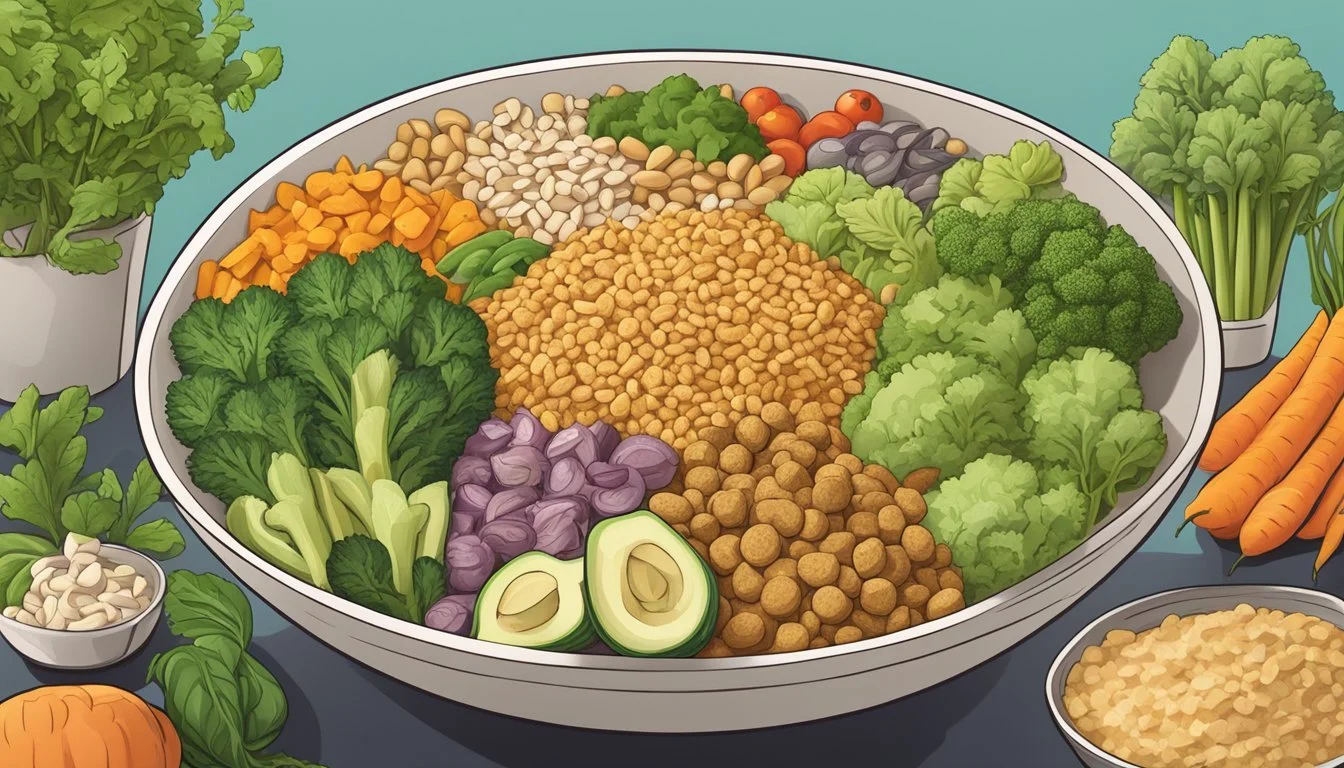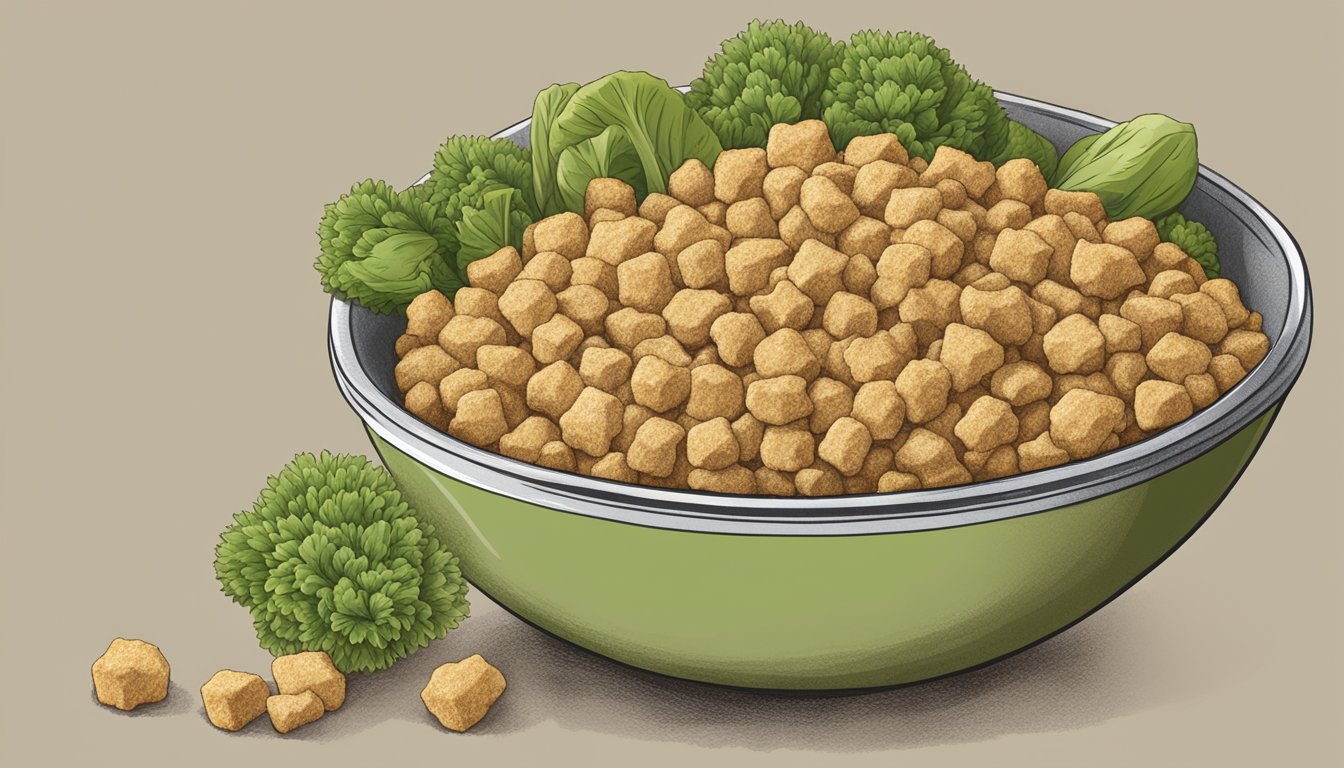Is Textured Vegetable Protein Vegan?
Unveiling Its Plant-Based Origins
Textured vegetable protein, commonly known as TVP, is a food product derived from soybeans and is revered for its versatility and protein content. As a dehydrated soy protein, TVP serves as a popular meat substitute that can readily absorb flavors, making it an appealing ingredient for those following a plant-based diet. The process of making TVP strips soybeans of oil and treats them until they become a dried, textured product that's both high in protein and fiber while being free of fat and cholesterol.
Given its origin from soybeans, TVP is inherently vegan, aligning well with vegan dietary practices which exclude all forms of animal exploitation and cruelty as much as possible within food, clothing, or any other purpose. As a foodstuff, it can be included in numerous recipes as a stand-in for meat, making it a staple in the vegan culinary world. Its attributes like being inexpensive, shelf-stable, and high in nutritional value contribute to its widespread use among those looking for plant-based protein sources.
TVP's growing popularity among vegans is due to its ability to serve as a sustainable protein option that also has a minimal environmental footprint compared to animal-derived proteins. Its production process requires less water and land, and it generates lower greenhouse gas emissions. By providing a texture akin to that of cooked ground meat, TVP can often be found in vegan and vegetarian versions of traditionally meat-heavy dishes, such as chili, tacos, and spaghetti Bolognese, making it a familiar and comforting choice for individuals embracing a vegan lifestyle.
What Is Textured Vegetable Protein?
Textured Vegetable Protein (TVP) is a versatile soy-based meat substitute known for its high protein content and similarity to ground meat in texture. It serves as a staple in many vegetarian and vegan diets.
Origins of TVP
TVP originated from the need to create a food product that could substitute for meat while providing essential nutrients. The material was developed from soy, a leguminous plant rich in protein, as an alternative that could mimic the texture and appearance of meat.
Ingredients and Process
The primary ingredient in TVP is defatted soy flour, a by-product of soybean oil extraction. During production, manufacturers:
Remove the fat from soybeans.
Process the remaining flour under high heat and pressure.
Shape it by an extrusion process.
This results in a textured product that can be flavored and sized for a variety of dishes.
Nutritional Profile
TVP boasts a notable nutritional profile, characterized by its:
High protein content, contributing to muscle repair and growth.
Considerable amounts of fiber, which aids in digestion.
Presence of magnesium, iron, and potassium, minerals essential for various bodily functions.
Low levels of carbohydrates and calories per serving, making it a fitting choice for energy-controlled diets.
In short, TVP is a nutrient-dense food option particularly suitable for those following a vegan lifestyle.
TVP in a Vegan Diet
In considering a vegan diet, the inclusion of proteins that align with plant-based eating principles is crucial. TVP, or textured vegetable protein, serves as a versatile substitute for meat in various recipes, providing the necessary protein without animal products.
Understanding Veganism
Veganism is a lifestyle choice that excludes all animal products and by-products, emphasizing plant-based foods for ethical, environmental, and health reasons. A vegan diet comprises fruits, vegetables, grains, nuts, seeds, and legumes, as well as alternatives to dairy and meat created from plants.
TVP as a Vegan Ingredient
Textured vegetable protein (TVP) is a high-protein, vegan meat alternative made from defatted soy flour—a by-product of soybean oil extraction. It is free from animal products, making it an essential protein source for vegans. When hydrated, TVP's texture closely resembles that of ground meat, thus it's often used in vegan recipes as a meat substitute.
Common Vegan Foods with TVP
Vegan Sloppy Joes: TVP acts as the ground beef substitute in this classic, saucy sandwich filling.
Vegan Cheese: While TVP is not a direct ingredient in vegan cheese, it is often accompanied by such alternatives in dishes like vegan cheeseburgers.
Vegan Schnitzel: A breaded, fried cutlet where TVP is seasoned and shaped to mimic the traditional meat version.
Vegan recipes frequently rely on TVP to mimic the texture and protein content of meat. It can be found in the form of granules or chunks and is used in a variety of vegan dishes like burgers, meatballs, and stews for its ability to absorb flavors and contribute to a balanced, plant-based diet.
Culinary Uses of TVP
Textured Vegetable Protein (TVP) is a versatile ingredient in the vegan kitchen, renowned for its capacity to mimic meat's textures and for its impressive flavor-absorbing qualities. When used in cooking, TVP serves as an excellent meat substitute and is often prepared by rehydration before inclusion in a variety of dishes.
TVP as Meat Alternative
TVP excels as a meat alternative because it can replicate the texture of ground beef or chicken in dishes such as burgers, tacos, sloppy joes, and meatballs. Chefs often favor it for its neutral flavor, which allows it to seamlessly integrate into recipes, assuming the taste profile of the seasonings and sauces used. This adaptability makes it a staple for creating vegan versions of traditionally meat-centric meals.
Rehydrating TVP
Before cooking, chefs typically rehydrate TVP to prepare it for meal incorporation. The process involves mixing the dehydrated TVP with hot water or vegetable broth at a standard 1:1 ratio. They allow the TVP to sit for about 10-15 minutes or until it has absorbed the liquid fully, becoming tender. Post-rehydration, TVP is ready to be sautéed, roasted, or added to dishes as a ground meat substitute.
TVP in World Cuisines
In addition to its popularity in common vegan and vegetarian dishes (What wine goes well with vegetarian dishes?), TVP has made its way into world cuisines, providing a meat-like consistency to a variety of international recipes. It's an asset in stews and bolognese, where it can mimic the heartiness of beef or pork. Textured Soy Protein (TSP) or TVP is incorporated into a myriad of flavorful vegan dishes, from Asian-inspired orange chicken made with TVP to Italian-style vegan meatballs that hold their shape and texture amidst robust tomato sauces.
Health and Nutritional Considerations
Textured Vegetable Protein (TVP) stands out as a high-protein, versatile meat substitute suitable for vegan diets, however, its nutritional profile and processing methods raise several considerations that consumers should be aware of.
Comparing TVP to Other Proteins
When evaluated against other protein sources, TVP offers a significant amount of protein, making it comparable to various meat-based proteins in terms of protein content. It's also low in fat, which can be beneficial for heart health. TVP is primarily made from soy, and therefore shares the nutritional benefits of other soy products like tofu and tempeh, albeit in a more processed form. As for gluten content, TVP is generally gluten-free, although one should always verify the label as cross-contamination can occur depending on the brand and processing facility.
Benefits of Including TVP
TVP is rich in the following nutrients:
Magnesium
Phosphorus
Iron
Zinc
B-vitamins (including B2 and B6)
Potassium
Folate
A cup of coarse grain TVP can contain roughly 222 calories and 23.1 grams of carbohydrates. Its commendable fiber content, with around 3 grams per serving, can support digestive health and slow the absorption of sugars, contributing to stabilizing blood glucose levels. As a plant-based food, TVP is also free of cholesterol and lower in saturated fats, further benefiting cardiovascular health.
Potential Concerns with TVP
While TVP is nutritionally dense, certain concerns exist related to its status as a processed food. The production of TVP often involves the use of hexane, a solvent used to extract oil from soybeans. Although most hexane is removed during processing, trace amounts could remain, leading some consumers to question the safety and purity of the product. Furthermore, soy contains phytoestrogens, which are plant-derived compounds with estrogen-like effects. While these have been deemed safe in moderate amounts, there is ongoing research into their long-term health effects. Given that TVP is a concentrated form of soy, these compounds are present and should be considered in the context of one's overall dietary phytoestrogen intake.
Buying and Storing TVP
Textured Vegetable Protein (TVP) is a versatile soy product available in multiple forms and is known for its long shelf life and economic value. Here's how to navigate its purchase and storage.
Forms and Varieties of TVP
TVP comes in an array of forms such as flakes, nuggets, chunks, strips, and granules. Unflavored varieties maintain a neutral taste, making them suitable for different recipes, whereas flavored options are seasoned to mimic various types of meat, offering convenient choices for quick meal preparation.
Purchasing TVP
Consumers can purchase TVP in the bulk section of health food stores, in pre-packaged bags, or online for added convenience. Given its popularity as a cheap, soy-based meat substitute, TVP is often stocked in the processed foods aisle. Consumers should look for terms like "textured soy protein" and "soy meat" on labels to ensure they are selecting the right product.
Storage Tips
TVP has an impressive shelf life, but it must be stored properly to maintain its quality. Dry storage in an airtight container is crucial to prevent moisture absorption. Kept away from heat and light, properly stored uncooked TVP can last for several months. Once rehydrated, it should be treated like cooked meat and refrigerated, consumed within a few days.
Preparing TVP at Home
Textured vegetable protein (TVP) is a highly versatile ingredient in the vegan kitchen, favored for its ability to mimic the texture and consistency of ground meat. Its preparation is straightforward—often beginning with rehydration—and it can adopt a variety of flavors, making it an excellent base for numerous dishes.
Basic Preparation Methods
The initial step in using TVP is rehydrating it, which involves soaking the dry substance in liquid until it becomes tender. A common ratio for rehydration is 1 part TVP to 1 part hot water or broth. For example:
1 cup TVP
1 cup boiling water or vegetable broth
One should mix them together and let the mixture sit, typically for about 5-10 minutes, until the TVP has absorbed the liquid and expanded. The result should be a soft, fluffy texture that's ready for further cooking.
Incorporating TVP into Recipes
Once rehydrated, TVP is ready to be incorporated into a range of recipes. Its neutral taste makes it like a blank canvas that can absorb any flavors, whether it's being seasoned with spices for a chili or simmered in soy milk for a creamy sauce. Textured vegetable protein can replace ground beef or mince in almost any dish, from burgers to tacos, with additional flavoring components (such as soy sauce, liquid smoke, or bouillon) enhancing its savory quality.
Here's how to use TVP as a ground meat substitute:
Rehydrate TVP with hot liquid.
Sauté with onions, garlic, and your choice of spices.
Integrate into your recipe as you would with ground meat.
Innovative TVP Dishes
Chefs and home cooks alike have devised countless innovative dishes that utilize TVP's adaptability. It can become a filling for stuffed bell peppers (What wine goes well with stuffed bell peppers?), an alternative for meatballs, or an addition to vegan meatloaf. Cooks can also flavor TVP with a combination of sauces, spices, and herbs, exploring cuisines from around the world. Some inventive TVP-based dishes include:
Vegan Popcorn Chicken: By seasoning TVP chunks with a blend of spices and a crunchy coating followed by air frying or baking.
Vegan BBQ Sandwich: TVP reconstituted with a smoky BBQ sauce served on warm buns with toppings such as coleslaw.
Mongolian Soy Curls: Sautéed TVP strips glazed with a sweet and spicy Mongolian sauce, serving as an enticing main course.
By mastering the preparation of textured vegetable protein, home cooks can enhance their vegan culinary repertoire with a nutritious and satisfying meat substitute.
TVP's Impact on Food Industry
Textured Vegetable Protein (TVP) has significantly shaped the food industry by offering an adaptable and protein-rich meat substitute for those on a vegan diet.
TVP as a Game Changer
In the context of meat alternatives, TVP has dramatically altered the landscape. Originating from soybeans, textured soy protein stands as a cornerstone for numerous vegan products like veggie burgers, soy chicken strips, and soy burgers. Its capacity to replicate the texture and nutritional profile of meats such as chicken and beef has made it an indispensable resource in the preparation of mock meats:
High-Protein Content: With up to 50g of protein per 100g, TVP competes robustly in nutrition with
FAQs on Textured Vegetable Protein
Textured Vegetable Protein (TVP) is a versatile, plant-based protein source made from soy flour, which is popular among vegans and vegetarians for its nutritional benefits and meat-like texture. However, there are some common questions regarding its suitability for everyone, especially those with dietary restrictions or allergies.
Can TVP Be Eaten by Everyone?
TVP is vegan-friendly and serves as a high-protein, low-fat alternative to meat. However, it may not be suitable for everyone. For individuals adhering to a gluten-free diet, it's important to check that the TVP brand specifies the product is free of gluten, as cross-contamination during processing can occur. Moreover, TVP should not be considered a whole food and may not be ideal for those seeking a diet based on minimally processed ingredients.
Is TVP Safe for Those with Soy Allergies?
TVP originates from soy, specifically defatted soy flour. Therefore, it is not safe for those with soy allergies. Soy is a common allergen, and individuals allergic to soy should avoid TVP and seek alternative protein sources.
How to Choose High-Quality TVP?
When shopping for high-quality TVP:
Look for non-GMO labels if avoiding genetically modified organisms is a priority.
Examine the packaging for certifications indicating the absence of gluten for those on a gluten-free diet.
Opt for brands that are transparent about their processing methods and source of soy.
Consider the nutritional profile, as some TVP products may have added vitamins and minerals.
Conclusion
Textured Vegetable Protein (TVP) is a highly versatile ingredient that fits well within a vegan diet. It is made from dehydrated soy protein, which makes it plant-based and suitable for those avoiding animal products. Rich in protein and other essential nutrients, TVP offers a substantial nutritional profile while being able to mimic the texture of meat when rehydrated and cooked.
Nutritional benefits of TVP include:
High in Protein: Vital for muscle repair and energy.
Low in Fat: Contributes to a balanced diet.
Fiber-Rich: Supports digestive health.
Contains Essential Nutrients: Such as iron, magnesium, and phosphorus.
TVP is also applauded for its affordability and ease of storage, making it an accessible option for many. Due to its neutral flavor, it absorbs seasonings and sauces effectively, allowing for diverse culinary uses from meat substitutes to enhancing textures in recipes.
In terms of environmental impact, TVP is considered a more sustainable choice compared to meat, given the lower resource requirements for soy cultivation. This aligns with the environmental aspect of veganism, which emphasizes minimizing one's ecological footprint.
In summary, TVP offers a nutrient-dense, sustainable, and flexible solution for those on a vegan diet seeking to enrich their meals with a meat-like texture without compromising their values.





